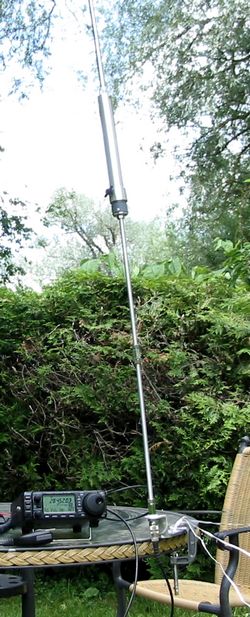Herwig online
> IC-703 [ Deutsch ]
 Comments
on the Icom IC-703
Comments
on the Icom IC-703
A Review of the QRP HF Transceiver
The IC-703 was manufactured by Icom from 2003 to 2010. It is a compact
transceiver for high-frequency (shortwave) amateur radio with up to 10 W
output power. While the first generation had some severe flaws like a
temperature-sensitive driver bias, these are mostly fixed in the rigs sold now.
The picture on the right shows the IC-703 together with an MP-1 antenna from
Superantennas (now sold as HF-P1 e.g. by Difona).
Pros:
- In spite of its many features, the transceiver has a logical and simple
user interface.
- Depending on the supply voltage, the operation mode can be switched
automatically between low-current drain (lights off, 5 W HF, 320 mA during
reception) and normal operation with 10 watts e.g. using a mains supply or a
car battery.
- An automatic tuner (ATU) is built in and works even with a relatively bad
SWR of 3:1 and more.
- You can display an SWR graph for a whole band which is ideal for tuning
mobile and portable antennas with coils.
- A speech compressor is built in, too. It significantly enhances the
readability of the transmitted QRP SSB signal as many reports have shown.
- The built-in band-scope function shows a graph with the spectrum of up to a
few hundred kHz.
- The receiver is very sensitive on all bands. Digital modes like PSK31 or
RTTY are perfectly supported.
- A DSP is used as a notch filter and also is able to reduce background noise
significantly.
- The dial knob has an acceleration function: Rotating it quickly increases
the frequency step width.
- The transceiver is a bit larger than the 5-W competitor FT-817 from Yaesu
but still quite compact.
Cons:
- There is no battery space in the rig, though it is no problem operating it
with a rechargeable 7-Ah gel battery for 10 hours or more. Instead, a supply
cable hangs out loosely from the transceiver.
- The rear speaker jack causes severe distortion of the audio. The reason is
probably a magnetic saturation in the RF choke between the outer jack contact
and the chassis ground (L7373) - obviously a design flaw. The front jack (which
can be switched between monaural speaker and stereo headphone operation using
the switch on the rear of the display panel) does not have this problem.
- The selectivity of the standard SSB filter is far from perfect and not
comparable e.g. with a TS-480 when strong stations are on adjacent frequencies.
Even signals on the unwanted sideband can be heard sometimes. It is only a
workaround to turn the passband tuning about one marker in the direction of a
higher-pitched audio.
- The SSB demodulator is not quite linear and causes a slight distortion of
received signals as long as the RF gain is not decreased manually.
- The LEDs for preamplifier and tuner are nearly unreadable in a sunlit
environment; LCD symbols would have done a better job.
Conclusion:
The IC-703 is primarily designed for portable use and works very well
for this purpose. Intermodulation issues reported earlier are mostly history
after most broadcast stations disappeared in the 7100 to 7200 kHz range since
March 2009. But even with an additional power amplifier (PA) it cannot compete
with a modern station transceiver, especially due to its limited selectivity.
It is also unclear why Icom was unable to fix the distortion problem with the
rear speaker jack for so many years.
More information:
- QRP is fun! It is no problem at all to work stations around the
world with 1 kW and a 5-element beam. But working DX successfully with 5 or 10
W and a simple antenna is something completely different.
- QRP operation requires a good antenna! With a dipole (2 x 20 m) in a
height of 10 m or an FD4 stations in a distance of
1000 km and more can be reached in the evening without any problems using 10 W
in SSB on 80 m, whereas a short whip with a tuning coil will result in much
less success at this power level.
- Higher bands (when open) require less power than lower bands, and
also a smaller antenna. It is much easier to work DX stations on 10/12/15 m
than on 20 or even 40 m. Of course this requires a few sunspots...
- QRP experiences: Don't call CQ; instead, call other stations when
you hear their CQ or when they have finished a QSO. Be aware that you probably
must hear them with S9+, otherwise they won't notice you: 10 W compared to 1 kW
is 20 dB difference, more than three S meter units. Try to turn the AF control
counterclockwise until the S meter shows S9 with no signal; the stations being
still loud then are potential QSO contacts.
- Only a fraction of the stations you can hear well will hear you.
Avoid to talk too long, otherwise others will call CQ on your frequency because
they think it is unused.
- A contest is a good chance to work many stations even with low
power.
- A pile-up is not an easy situation for a QRP station. However, your
chances improve the longer you wait. Let the 1-kW stations make their calls
first and simply return some time later.
- The MP-1 antenna from Superantennas works best on 14 MHz and above.
(7 MHz requires much longer radials than the ones supplied.) The radials should
be elevated about 0.5 to 0.7 m above the ground for a VSWR better than 1.5. The
50-MHz band can be used with the built-in tuner of the IC-703 which should be
left off for all shortwave bands.
- IC-703 manufacturer:
Icom Europe
 Comments
on the Icom IC-703
Comments
on the Icom IC-703 Comments
on the Icom IC-703
Comments
on the Icom IC-703